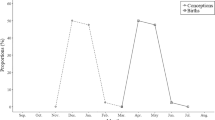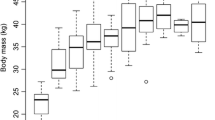Abstract
Reproductive and life history data of Arabian oryx founder females reintroduced into Mahazat as-Sayd Protected Area in Saudi Arabia were collected from 1990 to 2007. A General Linear Model revealed a significant effect of both age and reproductive experience prior to release on overall and male birth rates. We also found an effect on the overall birth rate explained by age alone. Our data are in line with theories suggesting that females reaching a stage in their life where they are unlikely to raise further off-spring increase their investment into progeny and skew sex ratio of their off-spring towards males. Inter-calf interval corresponds with findings from reintroductions in Oman and elsewhere in Saudi Arabia but increased with progressing age. Calving occurred throughout the year with no distinct seasonality. Fecundity was higher in experienced founder females, albeit not significantly. Overall fecundity was highest in young females, decreased in middle aged animals, and remained stable throughout the rest of their life span. Our findings may have an influence on future reintroductions of Arabian oryx and confirm theories in behavioural ecology of ungulates.
Similar content being viewed by others
References
Beck, B., Rapport, L.G., Stanley-Price, M.R., Wilson, A.C., 1994. Re-introduction of captive born animals. In: Olney, P.J.S., Mace, G.M., Fiestner, A.T.C. (Eds.), Creative Conservation: Interactive Management of Wild and Captive Animals. Chapman & Hall, London, pp. 265–268.
Bercovitch, F.B., Loomis, C.P., Rieches, R.G., 2009. Age-specific changes in reproductive effort and terminal investment in female Nile Lechwe. J. Mammal. 90 (1), 40–46.
Child, G., Grainger, J., 1990. A System Plan for Protected Areas for Wildlife Conservation and Sustainable Rural Development in Saudi Arabia—Appendix II. National Commission for Wildlife Conservation and Development, Riyadh, Saudi Arabia.
Clutton-Brock, T.H., Guinnes, F.E., Albon, S.D., 1982. Red Deer. Behaviour and Ecology of Two Sexes. Edinburgh University Press, Edinburgh.
Cunningham, P.L., 2008. Monitoring results: Mahazat as-Sayd–July 2008. Unpublished report. King Khalid Wildlife Research Centre, Thumamah, Saudi Arabia.
Cunningham, P., Wronski, T., 2010. Arabian wolf distribution update from Saudi Arabia. Canid News 13 (1) (online) http://www.canids.org/canidnews/13/Arabian_wolf_in_Saudi_Arabia.pdf.
Dytham, C., 1999. Choosing and Using Statistics: A Biologists Guide. Blackwell Science, London.
Fischer, M., Ghazanfar, S.A., Chaudhary, S.A., Seddon, P.J., Robertson, E.F., Omar, S., Abbas, J.A., Boer, B., 1998. In: Ghazanfar, S.A., Fischer, M. (Eds.), Vegetation of Arabia. Kluwer Academic, Netherlands.
Greth, A., Schwede, G., 1993. The reintroduction programme for the Arabian oryx Oryx leucoryx in Saudi Arabia. Intern. Zoo Yearb. 32, 73–80.
Harding, L.E., Abu-Eid, O.F., Hamidan, N., al Sha’lan, A., 2007. Reintroduction of the Arabian oryx Oryx leucoryx in Jordan: warand redemption. Oryx 41 (4), 478–487.
Henderson, D.S., 1974. Were they the last Arabian oryx? Oryx 12, 347–350.
Islam, M.Z., Ismail, K., Boug, A., 2010. Catastrophic die-off of globally threatened Arabian Oryx and Sand Gazelle in the fenced protected area of the arid central Saudi Arabia. Journal of Threatened Taxa 2, 677–684.
Kock, R.A., Soorae, P.S., Mohammed, O.B., 2007. Role of veterinarians in reintroductions. Intern. Zoo Yearb. 41, 24–37.
Mésochina, P., Bedin, E., Ostrowski, S., 2003a. Arabian oryx re-introduction in Uruq Bani Ma’arid Saudi Arabia: update with emphasis on mortality. Re-Introduction News 22, 38–39.
Mésochina, P., Bedin, E., Ostrowski, S., 2003b. Reintroducing antelopes into arid areas: lessons learnt from the oryx in Saudi Arabia. C. R. Biol. 326, S158–S165.
Mésochina, P., Bedin, E., Ismail, K., 2003c. Arabian oryx re-introduction into Mahazat as-Sayd protected area—Saudi Arabia: from rehabilitation to population management. Re-introduction News 23, 29–30.
Ostrowski, S., Bedin, E., Lenain, D.M., Abuzinada, A.H., 1998. Ten years of oryx conservation breeding in Saudi Arabia—achievements and regional perspectives. Oryx 32, 209–222.
Ostrowski, S., Williams, J.B., Bedin, E., Ismail, K., 2002. Water influx and food consumption of free living oryxes (Oryx leucoryx) in the Arabian desert in summer. J. Mammal. 83 (3), 665–673.
Ostrowski, S., Williams, J.B., 2006. Heterothermy of free-living Arabian sand gazelles (Gazella subgutturosa marica) in a desert environment. J. Exp. Biol. 209, 1421–1429.
Quinn, G.P., Keough, M.J., 2002. Experimental Design and Data Analysis for Biologists. Cambridge University Press, Cambridge.
Ryder, O.A., 1986. Species conservation and systematics: the dilemma of subspecies. Trends Ecol. Evol. 1, 10.
Ryder, O.A., 1987. Conservation action for Gazelles: an urgent need. Trends Ecol. Evol. 2 (6), 143–144.
Seddon, P.J., Ismail, K., 2000. Mahazat as-Sayd ungulate survey, May 2000. Unpublished report. National Wildlife Research Centre, Taif, Saudi Arabia.
Sempéré, A.J., Ancrenaz, M., Delhomme, A., Greth, A., Blanvillain, C., 1996. Length of estrous cycle and gestation in the Arabian Oryx (Oryx leucoryx) and the importance of the male presence for induction of postpartum estrous. Gen. Comp. Endocr. 101, 235–241.
Short, J., Bradshaw, S.D., Giles, J., Prince, R.I.T., Wilson, G.R., 1992. Reintroduction of macropods (Marsupialia Macropodoidea) in Australia—a review. Biol. Conserv. 62, 189–204.
Soorae, P.S., Seddon, P.J., 1998. Re-introduction Practitioner’s Directory. IUCN/SSC Re-introduction Specialist Group. NCWCD, Riyadh, Saudi Arabia.
Spalton, J.A., Lawrence, M.W., Brend, S.A., 1999. Arabian oryx reintroduction in Oman: successes and setbacks. Oryx 33, 168–175.
Stanley Price, M.R., 1989. Animal Re-introductions: the Arabian oryx. Cambridge University Press, Cambridge.
StanleyPrice, M.R., 1991. A review of mammal re-introductions, and the role of the Re-introduction Specialist Group of IUCN/SSC. Symp. Zool. Soc. Lond. 62, 9–25.
Strauss, W.M., 2002. An ecological study of the reintroduced Arabian oryx Oryx leucoryx (Pallas, 1777) in the Uruq Bani Ma’arid Protected Area of the Kingdom of Saudi Arabia. M.Sc. Thesis. University of Pretoria. Pretoria, South Africa.
Strauss, W.M., 2008. Where are we in terms of Arabian oryx conservation. Wildlife Middle East News 2 (4), 3–4.
Tabachnick, B.G., Fidell, L.S., 2001. Using Multivariate Statistics. Allyn and Bacon, Boston.
Talbot, L.M., 1960. A look at threatened species. Oryx 5, 240–247.
Treydte, A.C., Williams, J.B., Bedin, E., Ostrowski, S., Seddon, P.J., Marschall, E.A., Waite, T.A., Ismail, K., 2001. In search for the optimal management strategy for Arabian oryx. Anim. Conserv. 4, 239–249.
Trivers, R.L., Willard, D.E., 1973. Natural selection of parental ability to vary the sex ratio of offspring. Science 179, 90–92.
Vié, J.C., 1996. Reproduction biology of captive Arabian oryx (Oryx leucoryx) in Saudi Arabia. Zoo Biol. 15, 371–381.
Author information
Authors and Affiliations
Corresponding author
Rights and permissions
About this article
Cite this article
Wronski, T., Lerp, H. & Ismail, K. Reproductive biology and life history traits of Arabian oryx (Oryx leucoryx) founder females reintroduced to Mahazat as-Sayd, Saudi Arabia. Mamm Biol 76, 506–511 (2011). https://doi.org/10.1016/j.mambio.2011.01.004
Received:
Accepted:
Published:
Issue Date:
DOI: https://doi.org/10.1016/j.mambio.2011.01.004




